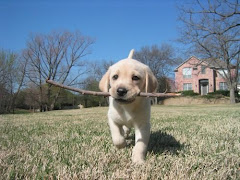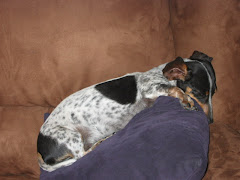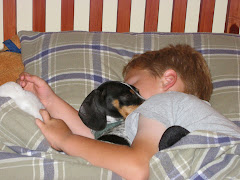1. Never hit or physically punish your puppy.
Make sure children aren't either. Instead, reinforce his positive behaviors with praise and treats (when he pees outside, sits for a toy or treat, chews on his toys, or even just lies quietly on the floor). Don't be afraid to use food as a motivator - you can phase it out later, after he knows English and is in the habit of obeying your commands. Use part or all of his daily food ration as a motivator for good behavior. If you scold or punish your puppy for bad behavior, yet ignore him when he is good, you are reinforcing bad behavior. Instead, withdraw attention from him when he's jumping up or barking, and enthusiastically praise when he's doing what you want, even if he's only sitting, looking at you or chewing one of his toys. The lack of your attention = enough punishment for a puppy.
2. Start Housetraining NOW.
Do not put housetraining off "until later". This is the one main reason people give up their dogs at 8-12 months of age - because they are tired of the "accidents". Housetraining, if done humanely and effectively, takes 1-3 months but boy, will you be glad you got it over with. Be consistent and patient, and remember that any accidents are your fault, not his). Never punish for submissive urination either. (See Resources below for links to Housetraining and Submissive Urination information articles.)
3. Start Socializing NOW.
Socializing your pup is the most important thing you can do during the first few weeks of his life. Most dog bites are due to the dog's fear and/or lack of exposure to the bitee or situation, so your pup needs to experience many new situations while he is very young. Don't force him into a situation he's shy about; let him meet people, children, and other dogs at his own pace. His most impressionable "imprint" period is from 3 weeks to 16 weeks of age; but socialization should continue throughout his adolescent months and adult years as well:
Human Socialization: Even before his vaccines, invite friends and relatives, particularly young children, to your house often. Keep a bowl of puppy food by the door so visitors can treat him when they arrive. Hold your puppy while you stand in front of a mall entrance and let passers-by say hello. Go to schools, shopping centers, nursing homes, and take walks with him in different neighborhoods when he's vaccinated. Keep in mind that a pup well-socialized to 6 year olds is not necessarily well-socialized to 2-year olds; make an effort to have him meet a very wide variety of children and adults.
NOTE: Never leave a baby or toddler alone with a puppy or dog. However, your pup should meet many babies and toddlers, so an adult should treat/praise the pup when holding or standing next to a small child. Supervise older children who may not understand the need for keeping fingers out of puppies' eyes or refraining from pulling painfully on their tails, nor how to approach a puppy or dog to prevent being jumped on.
Canine Socialization: Once he's had his vaccines, your pup should play with other healthy, friendly, vaccinated puppies and adult dogs as frequently as possible. Have a "puppy party" at your home. Bring him to the local park (always on leash). Sign up for a puppy kindergarten class. Bring him to your local pet superstore or a dog show, and consider dog daycare for fun, intensive, supervised dog socialization and vigorous exercise.
4. Practice Handling Exercises daily.
Baths, brushing, clipping nails, cleaning ears, examining and brushing teeth should become a regular and pleasant part of your pup's life. Include many tiny treats. Your goal is to have him look forward to being handled by you and the kids (supervise handling exercises with children and pre-teens). Go gradually, praise/treat throughout, and build on success.
Once daily, lift your pup's lip up for a quick instant and immediately praise and treat. Each day you'll be able to hold his lip up a bit longer. Now move to the other lip until he's OK with that too. Within a few weeks he will be happily allowing you to open his mouth for 10 seconds or more. You can also gradually get him used to your finger rubbing his outer gums and teeth. Once he's OK with that, incorporate some canine toothpaste (not human toothpaste) into daily 2 minute teeth-brushing sessions.
Use a similar, gradual technique to get your pup used to having his collar held and nails trimmed: Start with a quick touch at the collar and treat/praise. Each day you'll be able to touch this area longer, as long as you treat/praise each time and never move too fast. For nails/paws, start by simply touching one toe or gently holding a paw for 1 second, then quickly praise/treat. Gradually introduce the nail clipper; clip one nail one day (only the very tip) and add one nail each day, praise & treat. Ear checking & cleaning, brushing, and bathing should also be introduced to your pup and practiced frequently, with treats & praise.
5. Start Bite Inhibition NOW.
If you watch a litter of puppies playing, you'll notice that they spend much of their time biting and mouthing each other. Because your pup has very sharp teeth (but a weak jaw), his harder bites or mouthing hurt his littermates - so they yelp and refuse to play with him. Soon the pup learns that his pals won't play with him when he bites too hard. You and your children should mimic this puppy play behavior in daily life. Because an adult dog has duller teeth but a very powerful jaw, Bite Inhibition (a "soft mouth") is one of the most important lessons your pup can learn while his sharp baby teeth are still in. There are two phases to training Bite Inhibition:
Step 1: Practice several times daily for 3-4 weeks. (Best for pups up to 12 weeks of age but if you've never done bite inhibition exercises, this step can be used for older pups who have varied mouthing pressure) Allow pup to mouth/playbite. When he exerts slightly more pressure than usual, say "Ouch!" just loud enough that he stops in surprise, and immediately stop playing for a few seconds.
Now allow him to mouth again and repeat the "Ouch!" and stop playing steps several times until he ONLY mouths softly. If your pup is not responding to the "Ouch!", simply skip it and just stop playing and/or get up and move away for a minute, then start again. The point is to teach your pup that interaction with humans ends when he mouths too hard.
Step 2: (Only after Step 1 has been completed) Now, any and every time his teeth make contact with human skin, say "OUCH!" and immediately stop playing. Get up and leave, and/or ignore the pup for a minute or two. Your pup should now start to believe that humans are very sensitive and cannot stand the incredible pain of any tooth contact to their skin. The point of these bite inhibition exercises is to first teach your pup to have a "soft mouth", and then to teach him that the instant his teeth touch human skin, play time is over.
IMPORTANT: The "ouch" is not as important as the end of interaction, so if your pup doesn't respond to the "ouch" or seems to get more riled up, just skip it and simply stop playing or interacting in any way for a few minutes.
6. Start Chew Training now.
One of the most important tasks you have as a new puppy owner is to spend as much time as possible encouraging your pup to chew and play with appropriate chew toys. It is natural and necessary for puppies to chew -- as long as it's on something appropriate! But if your puppy chews on your coffee table, it's because:
§ puppies/dogs like to chew things
§ you didn't teach him what was appropriate to chew
§ he has nothing else to do
§ you left him access to the coffee table
Don't scold him for chewing your coffee table unless you catch him "in the act". A quick shout is usually enough: Say "Rex, OFF! Find your chew toy!" Then go and get a chew toy for him and praise him when he shows even the slightest interest.
If you punish your pup "after the fact", he won't learn not to chew that thing -- all he'll learn is "when the owner comes home, I get punished". This often increases his anxiety during the day, and he may start to chew even more! So how do you teach your dog what's right to chew and what's wrong?
Provide many appropriate chew toys. Keep half of them in the cupboard until he's bored with other ones. Then take up the old toys (for use later) and give him the new toys, one at a time with much fanfare. Remember, 10 good chew toys cost a lot less than a new coffee table. Appropriate chew toys are:
§ Kong or similar hard rubber toy with hollow center. Stuff these with kibble, treats, other goodies. We recommend 3 Kong toys per puppy.
§ Natural, bleached, or smoked bones with hollowed-out marrow area (for stuffing with kibble, peanut butter, etc.)
§ Twisted ropes. Soak in chicken or beef broth, then dry.
§ Limit rawhide and/or pig's ears to 1-2 per week maximum. Don't give him an old shoe or rag -- they teach him that shoes and clothes are OK to chew.
Praise, praise, praise each time your pup chews something right. Never take this action for granted. You should also make each toy particularly attractive by stuffing it with kibble, rubbing some kind of meat on it, or waggling it temptingly in front of his nose. As soon as your pup shows any interest in the toy, lavish him with praise.
Occasionally practice "entrapment": Bring your pup to something you do not want him to chew, and if he sniffs or mouths it, correct him with a quick shout as directed above. Now give him a good chew toy and praise when he takes it.
Until he truly understands chewing rules, never leave him alone with access to inappropriate chewables. A kitchen filled with stuffed Kongs, bones and ropes is usually a good place. A Buster Cube is also a great toy to occupy his mind while you're away.
Finally, keep your hello's and goodbye's very low-key and casual. Never make a fuss when you come home or leave; this can badly increase his anxiety while you're gone, and anxiety can increase destructive behavior. Before you leave the house for a while, let him outside to pee, then ignore him for the last 5 minutes before you leave. When you get home, take him outside and do not greet him until he has peed.
7. Correct bad behavior such as chewing or housesoiling only if you catch it "in the act" (within 3 seconds).
Otherwise, your pup will not understand why he is being corrected. A sudden, loud noise ("OUTSIDE!" if pup is caught housesoiling; "OFF" or "STOP!" or clapping rapidly if chewing) followed by praise when good behavior begins (you rush pup outside to finish peeing & praise/treat; you give stuffed chew toy and praise/treat). Bringing him to the "scene of the crime" does not improve his understanding; if you discover a mess, chalk the experience up to either not being there in time, or not having prevented the situation.
8. Start Basic Obedience Training now.
Research and join a group class which emphasizes positive reinforcement, and even more important: Practice at home as much as you possibly can. Avoid classes which require a choke or prong collar, harsh correction or jerking around. Using positive reinforcement your pup can clearly understand and obey basic commands like Sit, Stay, Down, Off, Come (Recall), and Heel by 6 months old. These basics will allow you to control a variety of situations and offer you a lifetime of communication with your dog. Make training a part of your life and it'll become a part of his - train in short, 5 minute intervals, several times daily or better yet 50 times per day, 10 seconds each!
9. Play with your puppy every day!
Play is an important and fun daily interaction - even if you only have 10 minutes to spare! Great games are Fetch (train by praise/treat when he returns the ball), Hide & Seek (treat when he finds you), and Tug-o-War (control with frequent "sit" and "down" breaks throughout). And even if you have a fenced yard, take him around the block for a daily on-leash walk - he needs the stimulation!
10. Recommended Reading/Viewing (all available at link in Resource Box below):
Positive Puppy Kindergarten DVD or VHS - by Suzanne Harris, Dog Days owner. Dog Days' entire 6-week Puppy Kindergarten class on dvd or vhs, 2 hours.
Positive Reinforcement Puppy Training - by Suzanne Harris, CPDT. A 130-page spiral bound instruction manual for puppy training which can be used alone or as a companion instruction book to "Positive Puppy Kindergarten" DVD above.
"Sirius Puppy Training" (video) - Highly recommended for all puppy owners, particularly families with children.
How to Teach a New Dog Old Tricks by Dr Ian Dunbar - Great basic book on positive reinforcement puppy training.
Recommended Reading: http://www.dogdaysusa.com/House Training: http://www.dogdaysusa.com/housetraining.cfmSubmissive Urination: http://www.dogdaysusa.com/urination.cfm
Dachshunds In Film: The Lemon Drop Kid
12 years ago













No comments:
Post a Comment